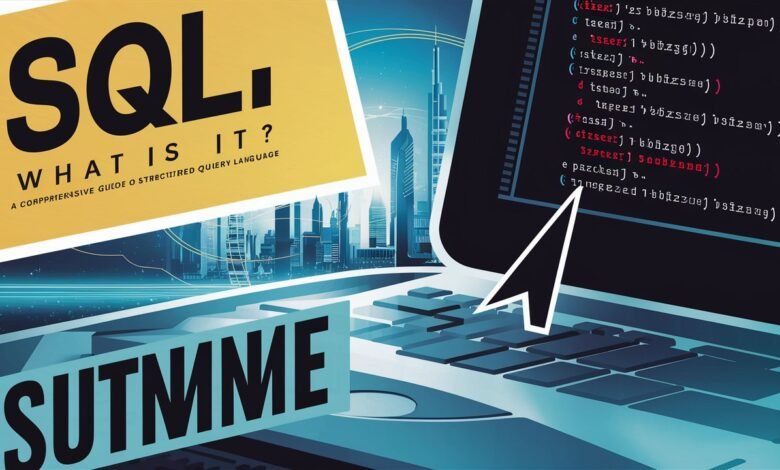SQL: What Is It? A Comprehensive Guide to Structured Query Language

Introduction
Structured Query Language (SQL) is the backbone of modern data management, powering everything from small business databases to global enterprise systems. But what exactly is SQL, and why is it so critical in today’s data-driven world? SQL is a domain-specific programming language designed for managing and manipulating relational databases. It enables users to create, modify, retrieve, and delete data while ensuring security, efficiency, and scalability. Whether you’re a developer, data analyst, or business professional, understanding SQL is essential for interacting with databases effectively. This article dives deep into SQL’s fundamentals, history, key concepts, and advanced features, providing a thorough understanding of its role in technology and business.
1. What Is SQL? Defining the Language of Databases
SQL, pronounced “ess-que-el” or “sequel,” is a standardized programming language used to communicate with relational database management systems (RDBMS). Its primary purpose is to store, retrieve, and manipulate structured data in tables composed of rows and columns. Unlike general-purpose programming languages like Python or Java, SQL is specialized for database operations, making it highly efficient for tasks such as querying data, updating records, or defining database schemas.
Relational databases like MySQL, PostgreSQL, Oracle, and Microsoft SQL Server rely on SQL to enforce data integrity, manage transactions, and control user access. For example, an e-commerce platform might use SQL to track inventory, process customer orders, and generate sales reports. The language’s declarative nature allows users to specify what they want from the database without detailing how to achieve it, simplifying complex operations.
2. The History of SQL: From SEQUEL to Standardization
SQL’s origins trace back to the 1970s when IBM researchers Donald Chamberlin and Raymond Boyce developed the language as part of the System R project. Initially called SEQUEL (Structured English Query Language), it was designed to manage large datasets in relational models proposed by Edgar F. Codd. By the late 1970s, commercial databases like Oracle adopted SQL, cementing its role in the industry.
In 1986, the American National Standards Institute (ANSI) standardized SQL, ensuring consistency across platforms. Subsequent updates (SQL:1999, SQL:2003, etc.) introduced features like window functions, JSON support, and procedural extensions. Today, SQL remains a living language, evolving to meet modern demands such as cloud computing and big data analytics.
3. Key Concepts of SQL
3.1 Data Definition Language (DDL)
DDL commands define and modify database structures. Keywords like CREATE, ALTER, and DROP build tables, indexes, and schemas. For instance, CREATE TABLE Employees (id INT, name VARCHAR(50)) generates a table to store employee data. DDL ensures databases are organized and scalable.
3.2 Data Manipulation Language (DML)
DML focuses on data manipulation. Commands like INSERT, UPDATE, and DELETE add or modify records. For example, UPDATE Employees SET salary = 60000 WHERE id = 101 adjusts an employee’s salary. DML operations are essential for maintaining dynamic, up-to-date datasets.
3.3 Data Control Language (DCL)
DCL manages permissions and security. Statements like GRANT and REVOKE control user access to database objects. A database administrator might use GRANT SELECT ON Employees TO HR_Team to allow HR personnel to view employee data without editing rights.
3.4 Data Query Language (DQL)
DQL is centered on retrieving data using the SELECT statement. Complex queries can filter, sort, and aggregate data. For example, SELECT department, AVG(salary) FROM Employees GROUP BY department calculates average salaries per department, showcasing SQL’s analytical power.
3.5 Transaction Control Language (TCL)
TCL commands like COMMIT and ROLLBACK ensure data consistency during transactions. If an error occurs while transferring funds between bank accounts, ROLLBACK undoes partial changes, preventing data corruption.
4. Why Is SQL Important? Applications Across Industries
SQL’s universality makes it indispensable. In finance, it detects fraud by analyzing transaction patterns. Healthcare systems use SQL to manage patient records and appointments. Marketing teams leverage it to segment customers based on purchase history. Even non-technical roles benefit: Business analysts use tools like Tableau (which runs SQL under the hood) to visualize trends, while managers generate performance reports.
Moreover, SQL integrates with programming languages like Python and R, enabling automation and advanced analytics. Platforms like Google BigQuery and Snowflake use SQL-like syntax for cloud-based data warehousing, proving its adaptability to modern infrastructure.
5. Advanced SQL Features: Beyond the Basics
Modern SQL supports advanced functionalities for complex use cases:
- Stored Procedures: Pre-written SQL scripts stored in the database for reuse, improving efficiency.
- Triggers: Aut
- omated actions (e.g., logging changes) triggered by specific events.
- Window Functions: Perform calculations across related rows without collapsing results (e.g., running totals).
- JSON Support: Store and query semi-structured data, bridging relational and NoSQL systems.
These features empower developers to build robust applications while maintaining performance.
6. Frequently Asked Questions (FAQs)
Q1: Is SQL the same as MySQL?
No. SQL is the language, while MySQL is an open-source RDBMS that uses SQL. Other systems include PostgreSQL and Microsoft SQL Server.
Q2: Can SQL handle big data?
Yes. Tools like Apache Hive and Spark SQL enable SQL-like querying on big data platforms like Hadoop.
Q3: How long does it take to learn SQL?
Basics can be mastered in weeks, but advanced techniques require months of practice.
Q4: What’s the difference between SQL and NoSQL?
SQL databases are relational and structured; NoSQL (e.g., MongoDB) is flexible for unstructured data.
Q5: Are SQL skills in demand?
Absolutely. Roles like data analyst, backend developer, and database administrator prioritize SQL proficiency.
Conclusion
SQL remains a cornerstone of data management decades after its inception. Its simplicity, versatility, and continuous evolution ensure it stays relevant in an era dominated by AI, IoT, and big data. Whether querying a small dataset or orchestrating a cloud warehouse, SQL provides the tools to turn raw data into actionable insights. By mastering SQL, professionals unlock opportunities to drive decision-making, optimize operations, and innovate across industries—proving that in the world of data, SQL is truly the language of power.



